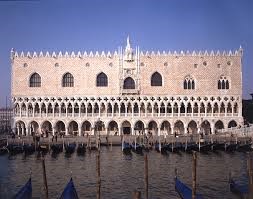The Doge’s Palace, the centre of Venetian power, residence of the doge and home to the judiciary, this is where the governance of the city took place. Visually, it is the perfect example of Venetian gothic architecture, as Ruskin put it: the perfect fusion of East and West. What we see from here is the third reconstruction of the palace, dating back to the 14th century. The original nucleus was built in the year 828, just after the body of Saint Mark’s had been transported into the city from Alexandria; the building was then rebuilt and expanded in the early 12th century.
The imposing balcony you see facing the basin of Saint Mark was built in 1404, at the top of which stands the figure of Justice, the major symbol ruling over Venice.
The façade on the basin side is a tapestry of alternate white and pink bricks, forming a flowery pattern dispersed with some darker green, grey or black bricks, resembling a multi-coloured blanket gracefully spread out across the palace’s façade.






